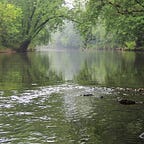CRWD ends big project year in uplands
Dobbins 1 — one of largest CIP works planned — among those completed in 2018 to improve water quality, reduce flooding
AUSTIN, Minn. — Friday, Dec. 21, 2018 — When flood-inducing rains hit Mower County, the Cedar River Watershed’s upland areas of Dobbins Creek now will have more ability to capture and slowly release large amounts of stormwater.
Improved water quality and reduced flooding, along with more wildlife habitat, are the benefits of five projects completed in recent weeks by the Cedar River Watershed District in upland areas of the Dobbins Creek subwatershed, which drains into Austin’s Jay C. Hormel Nature Center and East Side Lake before flowing to the Cedar River.
To date, CRWD now has completed nine of 25 projects planned under its nearly $8.4 million Capital Improvement Plan (CIP) focused on improving water quality and reducing floods. CIP’s overall goal is to reduce flooding by 8 percent at the Cedar-Dobbins confluence in southeast Austin.
Under this year’s work, CRWD hired contractors to build water-detention, earthen berms to control and treat stormwater flowing off more than 1,000 acres of mostly farmland in the nearly 25,000-acre Dobbins subwatershed. CRWD has focused in recent years on Dobbins due the subwatershed being prone to flash floods.
CIP projects are funded by a $3.2 million grant from The Hormel Foundation with nearly another $4 million thus far in funding from state grants and state bonding. Up to $1 million from a CRWD local project levy is available, if needed.
In 2019, CRWD plans to build up to six more CIP projects in the Dobbins subwatershed, treating an additional 1,000 acres overall. CIP focuses on upland water storage as it decreases the amount and speed of stormwater flow, which reduces the potential for significant downstream streambank erosion.
“By slowing stormwater, these CIP structures keep a lot of soil and nutrients from entering streams while reducing flood damage to buildings, roads, bridges and farm fields,” CRWD project manager Cody Fox said.
Dobbins 1 — one of the largest CIP projects planned — was finished in 2018 after several years of preliminary work with numerous landowners and complex designs. Treating more than 810 acres, Dobbins 1 is two, large berms in the upper areas of Dobbins Creek’s north branch (Red Rock and Dexter townships). At capacity, Dobbins 1’s storage will cover more land (more than 50 acres) with stormwater than Austin’s 40-acre East Side Lake — a reservoir created by a dam on Dobbins Creek.
“It feels great to have Dobbins 1 completed and ready to help with issues in our watershed,” Fox said. “Lots of work went into it, and we were fortunate to work with great landowners.”
At maximum capacity, Dobbins 1 should temporarily hold about 250 acre-feet of stormwater (81.5 million gallons), with some spots being more than 15 feet deep. One acre-foot is like covering a football field with one foot of water. At capacity storage, Dobbins 1 will release stormwater over two days rather than the typical eight to 12 hours at the site.
Under the project, 80 acres of farmland also were enrolled in the federal Conservation Reserve Program (CRP), keeping the land from being farmed for a decade.
With rainfall amounts that typically produce major flooding, Dobbins 1 will reduce peak stormwater flows by more than 80 percent at its site. The berms are expected to keep an estimated 134 tons of sediment out of Dobbins Creek along with 218 pounds of phosphorus equal to more than 65,000 pounds of algae.
Sediment is loose particles of sand, clay, silt and other substances mostly from eroding soils on land or streambanks. It makes streams cloudy, which is harmful to fish and plant life, and fills in lakes and streams.
Most sediment is contaminated by pollutants, particularly phosphorus, which, in excessive levels often from pastures and cropland, can cause water pollution by promoting significant algae growth. Water quality can be harmed further when bacteria consume dead algae and use up dissolved oxygen, suffocating fish and other aquatic life.
Three other projects built by CRWD in 2018 also are in the Dobbins headwaters areas of Dexter Township and each will reduce on-site, peak stormwater flows by 90 percent or more. Those included:
- Project #8 — Just north of Interstate 90, CRWD built a grass waterway and earthen berm to minimize on-site gully erosion and reduce the risk of heavy rain overtopping Mower County Road 20 directly downstream.
- Project #13 — This project built an earthen berm west of Dexter that will enhance the lifespan of a downstream, grass waterway while directing rain water into it. Prior to the work, heavy rains often led to water cutting through several areas of a fence line, causing erosion, including by skirting water outside of a grass waterway.
- Project #15 — Crews built an earthen berm west of Dexter along fence lines to minimize obstructions in the farm field and reduce the amount of cropland taken out of production.
To view an interactive story map and download photos related to the Dobbins 1 project, go online to:
